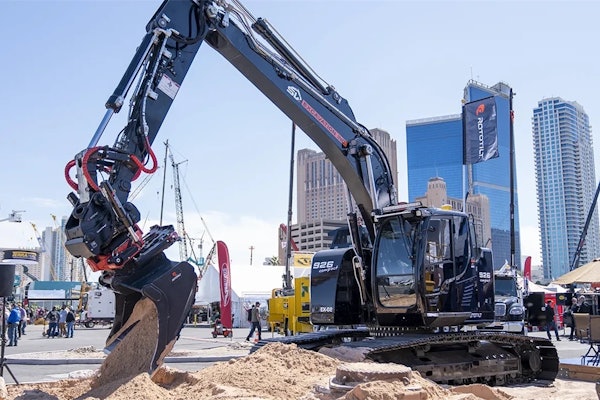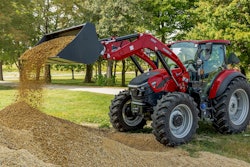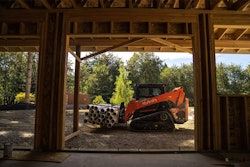Designed for medium to large earthmoving jobs, articulated dump trucks in the 20- to <26-ton class are a perfect fit for contractors working jobsites with long hauls and minimal haul roads or with muddy ground conditions. And although trucks in this class are among the smallest ADTs available today, they can still excel on adverse slopes, in sharp or blasted rock and mass excavating applications.
ADTs now tread in a domain once exclusively ruled by scrapers. ADT proponents say that scrapers – while still excellent earthmoving machines in some applications – are limited in versatility by their very design. Scrapers, they say, excel in shorter haul runs from 2,500 to 4,000 feet where they can "shave" material off the top of the land, stockpiling mounds and doing fine grading work.
"Compared to ADTs, scrapers have some downsides to them," says Michael Stec, product marketing specialist, Volvo Construction Equipment. "They have much higher fuel consumption than ADTs and higher operating costs due to ongoing maintenance and repair demands. Many times they require a dozer to assist them in difficult or muddy soil conditions, and they do not have the gradeability required for productive work in slick or high-sloped areas."
Position excavators above ADTs and load from the side
Today, ADTs are an increasingly popular earthmoving option, often used in conjunction with wheel loaders, or more commonly, hydraulic excavators. “Excavators are the preferred loading machine,” says Wayne Michels, vice president, product support, Moxy Trucks. “Under the right conditions, they can load an ADT of this size in two to two and a half minutes. Wheel loaders can take two or three times as long to load a truck because they have to move back and forth from the stockpile to the ADT. An excavator is stationary. Most of the time, using a wheel loader, you’ll lose a minute or more on each loading pass. That means reducing passes as much as possible becomes critical for good production.”
That said, there are applications where wheel loaders are the preferred loading machine. Models with bucket capacities ranging from 4 to 6 cubic yards are considered the best match-up for trucks in this class. Contractors should expect three to five passes to load 20- to <26-ton ADTs, with loading height and tipping height being the key wheel loader factors for optimal production. "Although a loader's bucket capacity may complement the hauler, if its tipping height is low, the last few passes will be pushed into the bed," Stec says. "This means the load isn't heaped, and it usually means the loader has to maneuver longer near the truck to dump its load. If the loader's tipping height is reasonably higher, the last couple of passes can be heaped into the bed and loading times remain fast."
Excavators typically load ADTs either from above or at the same level as the truck. In either scenario, Stec says, the excavator's depth should be roughly equal to the length of its dipper arm and 45-degree swing angles should be used when loading for maximum efficiency and quickness.
ADT operators can maximize tire life by not spinning them in slippery conditions, turning differential locks off when not needed and by slowing slightly around turns.
As with any earthmoving application, productivity goes hand-in-hand with efficiency. For that reason, says Tim Averkamp, product marketing manager, trucks and engines, John Deere Construction & Forestry Division, correctly sizing the excavators used with any class of ADT is crucial. “Optimally, you want the excavators in your fleet to be able to fill these 20- to <26-ton trucks in four to six passes," he says. "An ideal match will depend on many variables, including the type of material and bucket size being used." Averkamp recommends positioning excavators above ADTs whenever possible, and keeping arm swing angles under 120 degrees of rotation. "If the space permits," he adds, "I always recommend side-loading trucks as opposed to back loading. Side loading minimizes the amount of truck positioning required and allows the ADTs to move in and out of the excavation area quickly for faster haul cycle times and less idle time for the excavator."
Matching excavators to ADTs is always a somewhat delicate task, and you must take into account a number of variables unique to a specific job. "You don't want to be loading ADTs with oversized buckets," stresses Stec. "Although they may load the truck in fewer passes, they also tend to slow digging speeds and can make the excavator 'tippy,' which is a safety hazard. On the other hand, using too small a bucket will give you easier digging and quicker loading cycles, but longer loading times."
"I've seen excavators as big as 33 tons and as small as 21 tons used with these smaller ADTs," notes David Morice, ADT product manager, JCB. "Either size excavator will work well with these trucks in the proper application. But remember that the smaller an excavator you go with, the less efficient the operation will be. Smaller excavators take more passes to fill the truck."
As a general rule, Morice thinks optimized excavator/ADT matches are more crucial for contractors on jobsites with shorter haul routes. "Obviously, if it takes a truck five minutes to complete a haul cycle, then fast loading becomes paramount for high productivity," he explains. "But if a truck takes 20 minutes to complete a haul, the load time becomes less of a factor than the load capacity of the hauler.
Haul cycle length the key for determining ADT fleet size
Of course, no contractor interested in making money and meeting his production schedule is going to employ just one ADT on a 20-minute haul cycle, which raises the question: How many ADTs should be employed on a given job?
For Morice, calculating the optimum number of trucks for a jobsite is more a function of overall cycle times than anything else. “Your goal is to maximize your excavator’s productivity when it’s loading the trucks,” he says. “And the simplest way to do this is take your ADTs’ total cycle time and divide it into an excavator’s (or wheel loader’s) load cycle time.”
The math is pretty straightforward: If the total cycle time for an ADT is 10 minutes, and the loading cycle is two minutes, divide 10 by two, for five, which translates to five trucks needed to keep that excavator moving at all times.
That’s a simple scenario, but the real world isn’t always so cut and dried. Some jobs may start out with short haul roads that increase in distance as the project progresses. So you might have to start out with a smaller fleet of ADTs and gradually feed additional units into the lineup as they’re needed.
Contractors facing even more complex jobsite layouts can turn to modern technology to help them put the right number of ADTs on their haul roads. “Larger jobsites can get quite daunting,” says Bob Todd, senior project engineer, marketing, Caterpillar articulated trucks. “In these cases your local dealer can provide a wealth of relevant information. So can computer software tools available through dealerships. These programs can factor in site conditions, loading tools, materials, volume and time. The computer can then compare those factors with theoretical grade speeds, cycle times and total machine fleet productivity with actual production times to help you optimize your ADT fleet.”
Extending tire life is an easy way to maximize profits with ADTs. Avoid rough underfoot conditions whenever possible and make cornering maneuvers at sensible speeds. Also check tire inflation pressures often and consider alternating tire positions to even out tread wear.
Use circular haul routes to keep trucks on the move
Laying out proper haul roads is another key to ensuring ADT productivity. Remember that just because an articulated dump can bull its way through unimaginably difficult terrain, it’s not always best for your bottom line to have them do so.
“I was on a jobsite in Louisiana recently,” Michels says, “and the ADTs on site started hauling before the roads were put in. They were only averaging two trips an hour initially. Once the roads were in, the contractor’s productivity doubled because the trucks could suddenly make four trips an hour.”
Theoretically, it’s best to lay out haul roads according to distance, grade, rolling resistance and ground structure. Obviously, it’s in your best interest to keep the distances between the loading and dumping areas as short as possible. Grades should be kept at a minimum to increase cycle times but also to decrease fuel consumption. Rolling resistance is more difficult to control, and is affected by factors like the type of soil operated in, condition of the ground, its moisture content, tire load and diameter and width of the wheels on the ADT. If you can help improve any of these factors on a job, you’ll see a net increase in hauler speeds and an additional increase in fuel economy.
Roughness of the surfaces in the loading area, haul route and dump area also directly affect an ADT’s speed on site. Remember that it doesn’t take an extremely rough haul road for the operator and the truck to feel high stresses created by shaking and vibration. Operators will instinctively adapt the speed of the hauler to a level that is easier on himself and the truck, resulting in slower cycle times.
“Try to design your haul roads so they’re in a circular or oval pattern,” Michels suggests. “You don’t want to have your trucks maneuvering any more than they have to. Try to create a traffic flow that’s logical and productive because good haul times can be broken down by the minute and even little disruptions in the flow can cost you money.”
“Haul road design and maintenance requirements should support sound industry practices,” Todd says. “To maximize safe ADT working conditions, lay roads out with corners and crests designed to allow machine operators to see and avoid hazards when traveling at normal operating speeds. Always use worst-case scenarios when planning roads. Look at every factor present on the terrain – the smallest obstacle, longest stopping distance, highest expected speeds, wet roads – and use them when laying out routes and calculating haul times to get a realistic picture of your daily production.”
But even the best haul roads can deteriorate by weather or constant use. And one of the great attributes ADTs have is their ability to move easily through sloppy ground conditions. If you do have to operate your trucks in the muck, Averkamp says coaching your drivers on a few basic operating methods can save you time and headaches. “Correct use of inter-axle and differential locks is vital,” he says. “So is keeping the truck moving when you’re in poor underfoot conditions. At the same time, remind your drivers to minimizing use of the locks on hard pavement, which can cause internal component wear and tire scuffing.”
Regardless of ground conditions, Averkamp says it’s always a good idea for operators to allow trucks to get up to speed and maintain that speed as long as practical. “Frequent transmission shifting can increase overall fuel consumption and internal powertrain heat, which is not good for long component life,” he says.
“Keep a handle on excessive braking,” Todd advises. “Too many operators stomp down on the pedal following a speedy arrival to a stopping point. Instead, have your operators make the approach at a sensible speed while using the retarder to slow the truck. The retarder should also be used when negotiating a descent instead of feathering the brake pedal. Failure to follow those procedures can lead to brake overheating and premature brake wear. Also caution operators about leaving the truck bed raised when returning from the dumpsite. This causes high side loading factors at the body pivot bushings and can lead to premature component failure.”
Another good operating practice is not overloading the truck beyond the maximum payload recommended. Doing so can result in unsafe operating conditions. It can also prematurely age an ADT by contributing to accelerated tire wear and overloading of a truck’s structural components.









